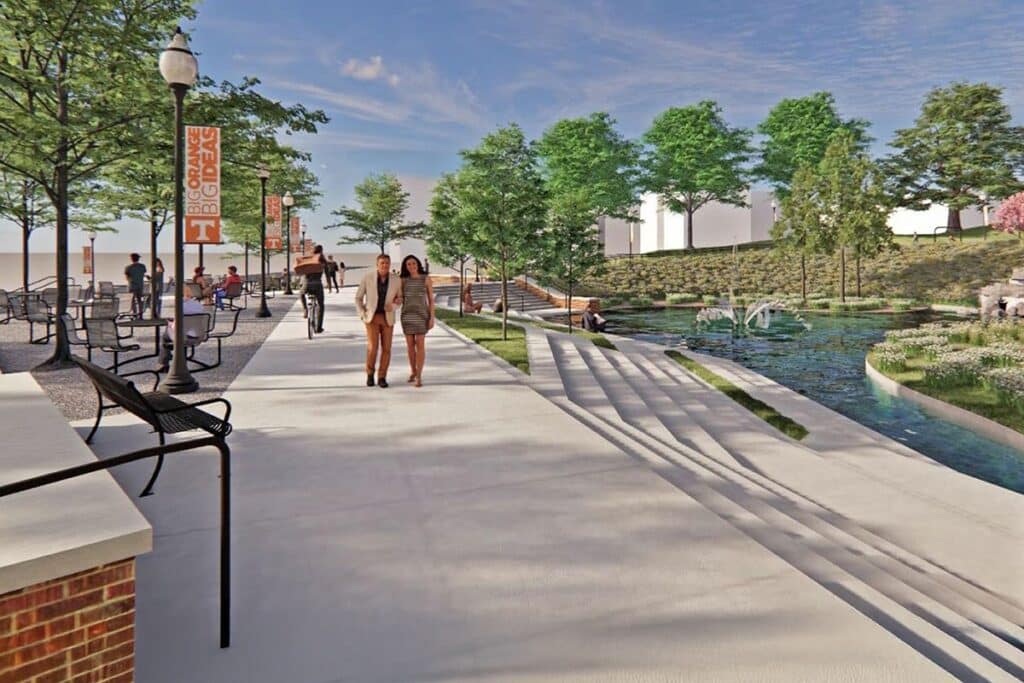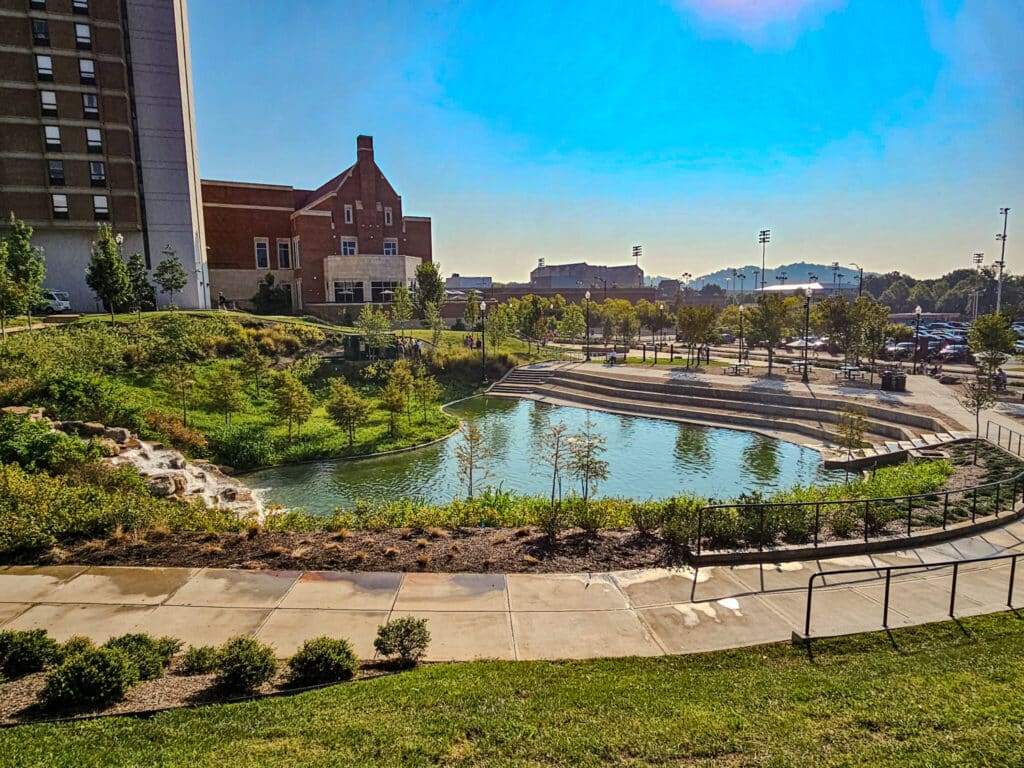Story by: Ella Kelley, FS Communications Student Assistant
Proactive Stewardship & Sustainable Solutions
The University of Tennessee, Knoxville, has experienced significant growth and change over the past 25 years. With more students comes a need for more parking and more academic buildings, but new construction can have an incredible impact on stormwater management and the availability of green spaces. Thankfully, UT takes a proactive approach in stewarding a beautiful and sustainable campus for future generations of Volunteers – most recently through the construction of the regional stormwater storage facility.
The regional stormwater storage facility is an innovative project that takes UT’s campus to the next level. It reflects the university’s sustainability efforts while enhancing the student experience on campus. The facility includes a stormwater pond with a waterfall feature, surrounded by plants and green spaces with tables and seating areas.

How It Works: Stormwater Management
The pond holds 155,000 gallons of stormwater runoff from nearby buildings. It is located on the corner of 20th and Andy Holt Drive, next to Rocky Top Dining Hall. The pond collects water in a concrete shell from the Pedestrian Mall, Rocky Top Dining Hall, South Carrick, and from the storage site itself.
Design & Construction
Design for the stormwater storage facility began in 2021, and construction started in spring of 2022. The facility was designed by Lose Designs and built by Southern Constructors. It was finished in August 2024, but it has faced several challenges. Since the project began, there have been several dropouts that have created setbacks in opening this feature for all to enjoy.
Due to a dropout that opened up beneath the pond floor in November 2024, crews had to deconstruct the pond’s waterfall feature and make repairs. Utilizing a process called cap grouting, crews drilled down to the bedrock below the pond and pumped concrete into the empty space. This process adds pressure which creates a cap. Once the cap is there, they raise a drill rig and pump in additional concrete every eight feet in a grid formation until they reach the surface. By repairing the dropout in this way, they are creating a concrete support bar below the surface that keeps the ground intact.
With the dropouts fixed and the project nearing completion, the team behind it is eager for students to be able to see the pond at its full potential.
Funding Through Stormwater Credits
This project was made possible through the university’s stormwater mitigation bank. The university has a stormwater runoff reduction policy that says that new projects that disturb over an acre of land have to manage or retain the first inch of stormwater that falls on the site following a 72-hour period with no measurable precipitation. This regulation encourages sustainable design and reduces flooding. Some strategies to follow this regulation include green infrastructure, permeable pavements, and rainwater storage systems. Residence halls sometimes use stormwater for laundry or irrigation as well. If projects do not want to collect stormwater, they can buy stormwater credits to build up the stormwater mitigation bank. Several projects bought credits that funded this stormwater storage facility project.
Filtration at Its Finest
The water collected and stored in the pond irrigates all of the Pedestrian Mall, Rocky Top Dining Hall, and the stormwater pond itself. When the water in the pond hits a certain level, it is pumped down to Fred Brown Residence Hall, where it travels through a dry creek bed. This creek bed has a great absorption rate, so the water is absorbed into the ground. If not all of the water is absorbed, it makes its way down to an underground cistern, which then pumps the water back into the pond.
The water goes through a filtration system to ensure it is clean. The filtration system is currently not running right now as they are repairing the waterfall, but when it runs, it involves a screen at the end of the pump intake that removes bigger particles like leaves, grasses, and algae. The water goes through a 30 and a 60 micron filter, which are tiny screens. It is then treated by UV light, which kills any bacteria that may be in the water. Every gallon of water should cycle through the filtration system once every 24 hours.
The water goes through these filters to ensure it is clean in case it gets on a tabletop or surface nearby as it irrigates. This is especially important as the tables surrounding the pond are likely to be used as an outdoor dining area.
Enhancing Campus Life
In addition to its sustainable benefits, the project will enhance the student experience by providing a park area for people to gather. The tables surrounding the pond and its location next to the dining hall gives it an outdoor dining feature. It creates a peaceful space for students, faculty, and staff to gather and relax with a meal or with friends. The sound of the waterfall and the appearance of the feature create a nice ambiance that breaks up the concrete jungle.

